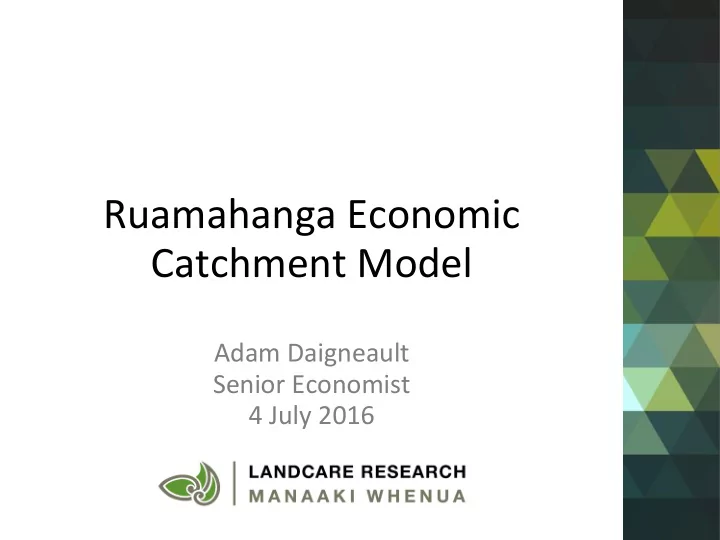

Ruamahanga Economic Catchment Model Adam Daigneault Senior Economist 4 July 2016
Economic Model as of 4/7/16
New Zealand Forest and Agriculture Regional Model (NZFARM) • A catchment-level economic model of NZ land use • Objective is to maximize income from land-based activities • Spatial scale at sub-catchment level • Models changes in land use and land management • Key outputs include changes in farm income, land use/mgmt • Can assess trade-off of multiple contaminants and policy approaches • Designed to consistently compare the relative economic & environmental impacts of a range of policy scenarios
Key Model Outputs $$$ Net Revenue (from on-farm production) Food (meat, milk, fruit, etc.) Raw materials (timber, pulp, wool, silage, etc.) Freshwater (N, P, E.coli , irrigated area) Erosion and Prevention (soil loss/retain by land use) Carbon Sequestration (exotic and native forest, grassland, etc.) Outputs will vary subject to: • Contaminant load target(s) • Policy mechanism • Mitigation cost and effectiveness
Methodology Economic costs and ecological benefits Scenarios, mitigation options, management costs Sediment Nutrients E.Coli Irrigation Ruamahanga Catchment & sub-catchments
Lifestyle Dairy 3% Support Other Dairy 4% 6% 10% Native Bush 24% Sheep & Beef Hort 43% 1% Mixed Other (Arable) Pasture Forestry 5% 1% 3%
Horti 7% Mixed Dairy (Arable) Forestry 33% 14% 3% Other 1% Sheep & Beef Dairy 36% Support 6%
Key Ruamāhanga catchment economic model baseline estimates Net Farm N leaching P loss Sediment E.coli Aggregated Land Use Area (ha) Revenue ($) (t) (t) (kt) (peta) Dairy 35,739 66,499,471 1,045 33 10 28 Dairy Support 14,880 13,066,002 965 16 16 9 Sheep & Beef 154,276 72,496,361 2,045 136 378 74 Other Pasture 2,750 2,354,785 52 1 5 1 Forestry 11,306 5,174,823 34 2 23 3 Mixed (Arable) 16,742 27,623,821 653 7 7 4 Horticulture 2,352 13,202,910 20 0 0 1 Native Bush 85,843 0 86 9 365 4 Lifestyle 12,207 0 330 5 4 7 Other 22,898 0 56 0 4 3 Ruamahanga Total 358,993 $200,417,788 5285 209 813 135
NZFARM test scenarios for the Ruamāhanga catchment N Leach P Loss Target Sedimen t Target E. coli Scenario Name Description Target Target Management Actions All dairy, sheep & beef, and dairy support farms All Farms M1 n/a n/a n/a n/a implement M1 mitigation bundle All dairy, sheep & beef, and dairy support farms All Farms M2 n/a n/a n/a n/a implement M2 mitigation bundle All dairy, sheep & beef, and dairy support farms All Farms M3 n/a n/a n/a n/a implement M3 mitigation bundle Minimum Feasible Loa ds Afforestation of all non-native land in the Convert All to catchment to estimate the minimum loads n/a n/a n/a n/a Forest possible Contaminant load reduction targets 10% reduction in N, P, and sediment for entire 10% catchment 10% 10% 10% 0% Ruamahanga catchment 10% reduction in N, P, and sediment for each 10% FMU 10% 10% 10% 0% FMU in the Ruamahanga catchment
Key ‘test’ model scenario estimates Total Annual Net Revenue N Leach P Loss (t) Sediment E.coli Scenario Cost ($/yr) ($) (t) (kt) (peta) Baseline $0 $200,679,150 5,285 209 814 134.7 % Change from no mitigation baseline All Farms M1 $583,436 0% 0% 0% 0% -4% All Farms M2 $18,270,930 -9% -10% -7% -9% -4% All Farms M3 $27,926,712 -14% -10% -48% -25% -4% Convert All to Forest $108,954,857 -54% -82% -82% -41% -84% 10% catchment $12,193,487 -6% -10% -15% -10% -3.7% 10% FMU $15,713,580 -8% -10% -28% -10% -3.0%
Mitigation Practice Area 400,000 350,000 300,000 250,000 area (ha) Afforest 200,000 M3 M2 150,000 M1 100,000 No Mitigation 50,000 0 Baseline All M1 All M2 All M3 Convert to 10% 10% All Forest reduction reduction RC FMU
Annual Cost by Land Use $120,000,000 Other Lifestyle $100,000,000 Native Bush Horticulture Mixed (Arable) $80,000,000 Forestry Other Pasture $60,000,000 Sheep & Beef Dairy Support $40,000,000 Dairy $20,000,000 $- All M1 All M2 All M3 Convert to All 10% 10% Forest reduction RC reduction FMU
Net Farm Revenue
Net Farm Revenue
Recommend
More recommend